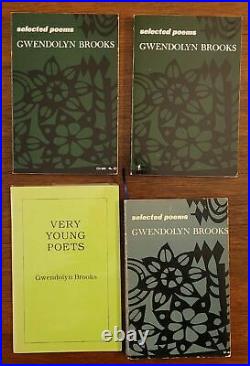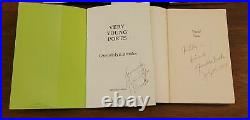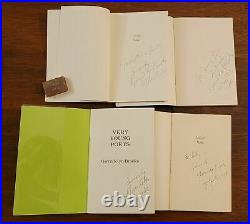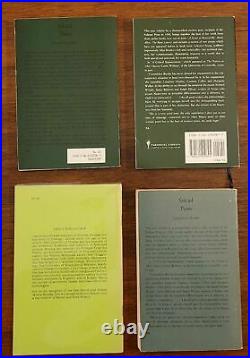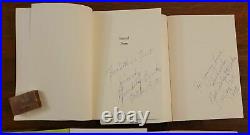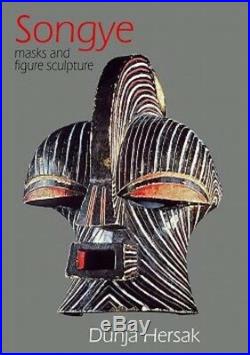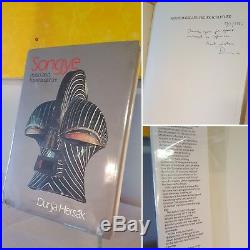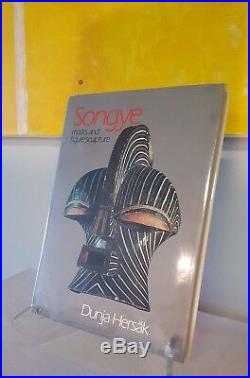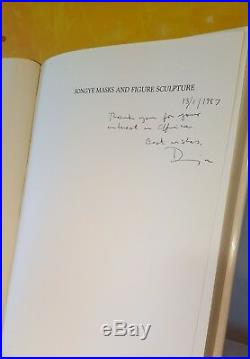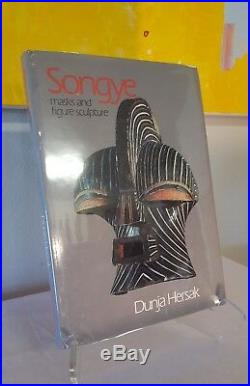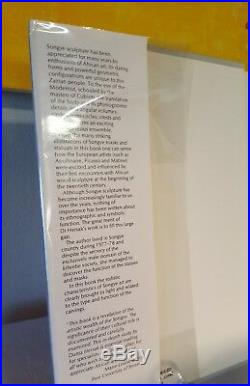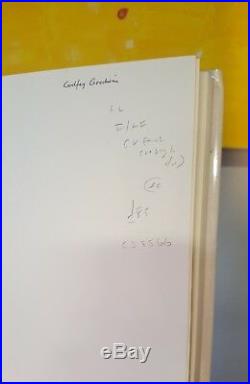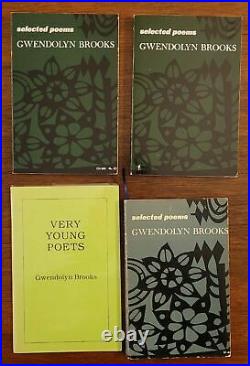
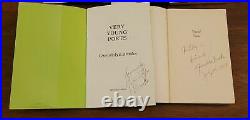
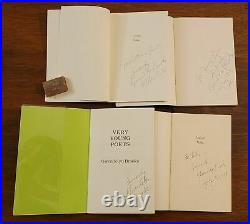
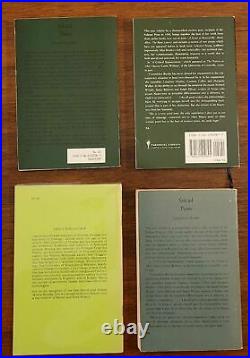
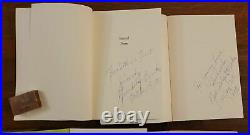

4 SIGNED BOOKS BY THE FIRST AFRICAN AMERICAN TO WIN A PULIZE PRIZE GWENDOLYN BROOKS. INSCRIBED BY GWNDOLYN BROOKS ON OCTOBER 18, 1983. INSCRIBED BY GWENDOLYN BROOKS ON MAY 25, 1992. SIGNED BY GWENDOLYN BROOKS. INSCRIBED BY GWENDOLYN BROOKS ON JULY 12, 1968. Gwendolyn Elizabeth Brooks was an American poet, author, and teacher. Her work often dealt with the personal celebrations and struggles of ordinary people in her community. She won the Pulitzer Prize for Poetry on May 1, 1950, for Annie Allen, making her the first African American to receive a Pulitzer Prize. Gwendolyn Brooks is one of the most highly regarded, influential, and widely read poets of 20th-century American poetry. She was a much-honored poet, even in her lifetime, with the distinction of being the first Black author to win the Pulitzer Prize. She also was poetry consultant to the Library of Congress-the first Black woman to hold that position-and poet laureate of the State of Illinois. Many of Brooks’s works display a political consciousness, especially those from the 1960s and later, with several of her poems reflecting the civil rights activism of that period. Her body of work gave her, according to critic George E. Kent, a unique position in American letters. Not only has she combined a strong commitment to racial identity and equality with a mastery of poetic techniques, but she has also managed to bridge the gap between the academic poets of her generation in the 1940s and the young Black militant writers of the 1960s. Brooks was born in Topeka, Kansas, but her family moved to Chicago when she was young. Her father was a janitor who had hoped to become a doctor; her mother was a schoolteacher and classically trained pianist. They were supportive of their daughter’s passion for reading and writing. Brooks was 13 when her first published poem, “Eventide, ” appeared in American Childhood; by the time she was 17 she was publishing poems frequently in the Chicago Defender, a newspaper serving Chicago’s African American population. After attending junior college and working for the National Association for the Advancement of Colored People, she developed her craft in poetry workshops and began writing the poems, focusing on urban Black experience, that comprised her first collection, A Street in Bronzeville (1945). Her poems in A Street in Bronzeville and the Pulitzer Prize-winning Annie Allen (1949) were “devoted to small, carefully cerebrated, terse portraits of the Black urban poor, ” commented Richard K. Barksdale in Modern Black Poets: A Collection of Critical Essays. Brooks once described her style as “folksy narrative, ” but she varied her forms, using free verse, sonnets, and other models. Several critics welcomed Brooks as a new voice in poetry; fellow poet Rolfe Humphries wrote in the New York Times Book Review that “we have, in A Street in Bronzeville, a good book and a real poet, ” while Saturday Review of Literature contributor Starr Nelson called that volume a work of art and a poignant social document. ” In Annie Allen, which follows the experiences of a Black girl as she grows into adulthood, Brooks married social issues, especially around gender, with experimentation: one section of the book is an epic poem, “The Anniad-a play on The Aeneid. Langston Hughes, in a review of Annie Allen for Voices, remarked that the people and poems in Gwendolyn Brooks’ book are alive, reaching, and very much of today. In the 1950s Brooks published her first and only novel, Maud Martha (1953), which details its title character’s life in short vignettes. Maud suffers prejudice not only from white people but also from lighter-skinned African Americans, something that mirrored Brooks’s experience. Eventually, Maud takes a stand for her own dignity by turning her back on a patronizing, racist store clerk. One way of looking at the book, then, commented Harry B. Shaw is as a war with. People’s concepts of beauty. ” In a Black World review, Annette Oliver Shands noted the way in which “Brooks does not specify traits, niceties or assets for members of the Black community to acquire in order to attain their just rights. So, this is not a novel to inspire social advancement on the part of fellow Blacks. Nor does it say be poor, Black and happy. The message is to accept the challenge of being human and to assert humanness with urgency. Brooks’s later work took on politics more overtly, displaying what National Observer contributor Bruce Cook termed an intense awareness of the problems of color and justice. ” Toni Cade Bambara reported in the New York Times Book Review that at the age of 50 “something happened to Brooks, a something most certainly in evidence in In the Mecca (1968) and subsequent works-a new movement and energy, intensity, richness, power of statement and a new stripped lean, compressed style. A change of style prompted by a change of mind. This shift or change is often depicted as the result of Brooks’s attendance at a gathering of Black writers at Fisk University in 1967; however, recent scholars such as Evie Shockley and Cheryl Clark challenge the idea that Brooks’s career can be so neatly divided. Clark, for example, has described In the Mecca as Brooks’s final seminar on the Western lyric. Brooks herself noted that the poets at Fisk were committed to writing as Blacks, about Blacks, and for a Black audience. If many of her earlier poems had fulfilled this aim, it was not due to conscious intent, she said; but from this time forward, Brooks thought of herself as an African determined not to compromise social comment for the sake of technical proficiency. Although In the Mecca and Brooks’s subsequent works have been characterized as possessing what a Virginia Quarterly Review critic called “raw power and roughness, ” several commentators emphasized that these poems are neither bitter nor vengeful. Instead, according to Cook, they are more “about bitterness” than bitter in themselves. Essayist Charles Israel suggested that In the Mecca’s title poem, for example, shows a deepening of Brooks’s concern with social problems. A mother has lost a small daughter in the block-long ghetto tenement, the Mecca; the long poem traces her steps through the building, revealing her neighbors to be indifferent or insulated by their own personal obsessions. The mother finds her little girl, who “never learned that black is not beloved, ” who “was royalty when poised, / sly, at the A and P’s fly-open door, ” under a Jamaican resident’s cot, murdered. Other poems in the book, occasioned by the death of Malcolm X or the dedication of a mural of Black heroes painted on a Chicago slum building, express Brooks’s commitment to her community’s awareness of themselves as a political as well as a cultural entity. Brooks’s activism and her interest in nurturing Black literature led her to leave major publisher Harper & Row in favor of fledgling Black publishing companies. In the 1970s, she chose Dudley Randall’s Broadside Press to publish her poetry collections Riot (1969), Family Pictures (1970), Aloneness (1971), Aurora (1972), and Beckonings (1975) and Report from Part One (1972), the first volume of her autobiography. She edited two collections of poetry-A Broadside Treasury (1971) and Jump Bad: A New Chicago Anthology (1971)-for the Detroit-area press. The Chicago-based Third World Press, run by Haki R. Lee, one of the young poets she had met during the 1960s-also brought many Brooks titles into print. Brooks was the first writer to read in Broadside’s original Poet’s Theatre series and was also the first poet to read in the second opening of the series when the press was revived under new ownership in 1988. Brooks, however, felt that Riot, Family Pictures, Beckonings, and other books brought out by Black publishers were given only brief notice by critics of the literary establishment because they did not wish to encourage Black publishers. Later Brooks poems continue to deal with political subjects and figures, such as South African activist Winnie Mandela, the onetime wife of antiapartheid leader-and later president of the country-Nelson Mandela. Brooks once told interviewer George Stavros: I want to write poems that will be non-compromising. I don’t want to stop a concern with words doing good jobs, which has always been a concern of mine, but I want to write poems that will be meaningful. Things that will touch them. Brooks’s work was objective about human nature, several reviewers observed. Janet Overmeyer noted in the Christian Science Monitor that Brooks’s particular, outstanding, genius is her unsentimental regard and respect for all human beings. She neither foolishly pities nor condemns-she creates. ” Overmeyer continued, “From her poet’s craft bursts a whole gallery of wholly alive persons, preening, squabbling, loving, weeping; many a novelist cannot do so well in ten times the space. ” Littlejohn maintained that Brooks achieves this effect through a high “degree of artistic control, ” further relating, “The words, lines, and arrangements have been worked and worked and worked again into poised exactness: the unexpected apt metaphor, the mock-colloquial asides amid jewelled phrases, the half-ironic repetitions-she knows it all. ” More important, Brooks’s objective treatment of issues such as poverty and racism “produces genuine emotional tension, the critic wrote. Among Brooks’s major prose works are her two volumes of autobiography. When Report from Part One was published, some reviewers expressed disappointment that it did not provide the level of personal detail or the insight into Black literature that they had expected. “They wanted a list of domestic spats, ” remarked Brooks. Bambara noted that it is not a sustained dramatic narrative for the nosey, being neither the confessions of a private woman poet or the usual sort of mahogany-desk memoir public personages inflict upon the populace at the first sign of a cardiac. It documents the growth of Gwen Brooks. Other critics praised the book for explaining the poet’s new orientation toward her racial heritage and her role as a poet. New consciousness and trudge-toward-progress. I know that the Black-and-white integration concept, which in the mind of some beaming early saint was a dainty spinning dream, has wound down to farce. I know that the Black emphasis must be not against white but FOR Black. In the Conference-That-Counts, whose date may be 1980 or 2080 (woe betide the Fabric of Man if it is 2080), there will be no looking up nor looking down. ” In the future, she envisioned “the profound and frequent shaking of hands, which in Africa is so important. The shaking of hands in warmth and strength and union. Brooks put some of the finishing touches on the second volume of her autobiography while serving as poetry consultant to the Library of Congress. Brooks was 68 when she became the first Black woman to be appointed to the post. Similar visits to colleges, universities, prisons, hospitals, and drug rehabilitation centers characterized her tenure as poet laureate of Illinois. In that role, she sponsored and hosted annual literary awards ceremonies at which she presented prizes funded “out of her own pocket, which, despite her modest means, is of legendary depth, ” Reginald Gibbons related in Chicago Tribune Books. She honored and encouraged many poets in her state through the Illinois Poets Laureate Awards and Significant Illinois Poets Awards programs. Proving the breadth of Brooks’s appeal, poets representing a wide variety of “races and. Poetic camps” gathered at the University of Chicago to celebrate the poet’s 70th birthday in 1987, Gibbons reported. Brooks brought them together, he said, in. A moment of good will and cheer. In recognition of her service and achievements, a junior high school in Harvey, Illinois, was named for her, and she was similarly honored by Western Illinois University’s Gwendolyn Brooks Center for African-American Literature. In 2017 celebrations of the centenary of Brooks’s birth were held at the University of Chicago and the University of Illinois, Champaign-Urbana, where Gwendolyn Brooks’s papers are held. Gwendolyn Elizabeth Brooks (June 7, 1917 – December 3, 2000) was an American poet, author, and teacher. She won the Pulitzer Prize for Poetry on May 1, 1950, for Annie Allen, [1] making her the first African American to receive a Pulitzer Prize. Throughout her prolific writing career, Brooks received many more honors. A lifelong resident of Chicago, she was appointed Poet Laureate of Illinois in 1968, a position she held until her death 32 years later. [4] She was also named the Poet Laureate Consultant in Poetry to the Library of Congress for the 1985-86 term. [5] In 1976, she became the first African-American woman inducted into the American Academy of Arts and Letters. Gwendolyn Elizabeth Brooks was born on June 7, 1917, in Topeka, Kansas. [2] She was the first child of David Anderson Brooks and Keziah (Wims) Brooks. Her father, a janitor for a music company, had hoped to pursue a career as a doctor but sacrificed that aspiration to get married and raise a family. Her mother was a school teacher as well as a concert pianist trained in classical music. Brooks’ mother had taught at the Topeka school that later became involved in the famous Brown v. Board of Education racial desegregation case. [7] Family lore held that Brooks’ paternal grandfather had escaped slavery to join the Union forces during the American Civil War. When Brooks was six weeks old, her family moved to Chicago during the Great Migration, and from then on, Chicago remained her home. She would closely identify with Chicago for the rest of her life. In a 1994 interview, she remarked. Living in the city, I wrote differently than I would have if I had been raised in Topeka, KS… Living there has given me a multiplicity of characters to aspire for. I hope to live there the rest of my days. That’s my headquarters. She started her formal education at Forestville Elementary School on Chicago’s South Side. [10] Brooks then attended a prestigious integrated high school in the city with a predominantly white student body, Hyde Park High School; transferred to the all-black Wendell Phillips High School; and finished her schooling at integrated Englewood High School. According to biographer Kenny Jackson Williams, due to the social dynamics of the various schools, in conjunction with the era in which she attended them, Brooks faced much racial injustice. Over time, this experience helped her understand the prejudice and bias in established systems and dominant institutions, not only in her own surroundings but in every relevant American mindset. Brooks began writing at an early age and her mother encouraged her, saying, You are going to be the lady Paul Laurence Dunbar. [12] During her teenage years, she began submitting poems to various publications. By the time she had graduated from high school in 1935, she was already a regular contributor to The Chicago Defender. After her early educational experiences, Brooks never pursued a four-year college degree because she knew she wanted to be a writer and considered it unnecessary. I’m just a writer who loves to write and will always write. [9] She graduated in 1936 from a two-year program at Wilson Junior College, now known as Kennedy-King College, and worked as a typist to support herself while she pursued her career. Song of Winnie’, Library Walk, New York City. Brooks published her first poem, “Eventide”, in a children’s magazine, American Childhood, when she was 13 years old. [6] By the age of 16, she had already written and published approximately 75 poems. At 17, she started submitting her work to “Lights and Shadows, ” the poetry column of the Chicago Defender, an African-American newspaper. Her poems, many published while she attended Wilson Junior College, ranged in style from traditional ballads and sonnets to poems using blues rhythms in free verse. In her early years, she received commendations on her poetic work and encouragement from James Weldon Johnson, Richard Wright and Langston Hughes. [13] James Weldon Johnson sent her the first critique of her poems when she was only sixteen years old. Her characters were often drawn from the inner city life that Brooks knew well. She said, I lived in a small second-floor apartment at the corner, and I could look first on one side and then the other. There was my material. By 1941, Brooks was taking part in poetry workshops. A particularly influential one was organized by Inez Cunningham Stark, an affluent white woman with a strong literary background. Stark offered writing workshops at the new South Side Community Art Center, which Brooks attended. [14] It was here she gained momentum in finding her voice and a deeper knowledge of the techniques of her predecessors. Renowned poet Langston Hughes stopped by the workshop and heard her read “The Ballad of Pearl May Lee”. [14] In 1944, she achieved a goal she had been pursuing through continued unsolicited submissions since she was 14 years old: two of her poems were published in Poetry magazine’s November issue. In the autobiographical information she provided to the magazine, she described her occupation as a “housewife”. Brooks’ published her first book of poetry, A Street in Bronzeville (1945), with Harper & Brothers, after a strong show of support to the publisher from author Richard Wright. He said to the editors who solicited his opinion on Brooks’ work. There is no self-pity here, not a striving for effects. She takes hold of reality as it is and renders it faithfully. She easily catches the pathos of petty destinies; the whimper of the wounded; the tiny accidents that plague the lives of the desperately poor, and the problem of color prejudice among Negroes. The book earned instant critical acclaim for its authentic and textured portraits of life in Bronzeville. Brooks later said it was a glowing review by Paul Engle in the Chicago Tribune that “initiated My Reputation”. [14] Engle stated that Brooks’ poems were no more “Negro poetry” than Robert Frost’s work was “white poetry”. Brooks received her first Guggenheim Fellowship in 1946 and was included as one of the “Ten Young Women of the Year” in Mademoiselle magazine. Brooks’ second book of poetry, Annie Allen (1949), focused on the life and experiences of a young Black girl growing into womanhood in the Bronzeville neighborhood of Chicago. The book was awarded the 1950 Pulitzer Prize for poetry, and was also awarded Poetry magazine’s Eunice Tietjens Prize. In 1953, Brooks published her first and only narrative book, a novella titled Maud Martha, which in a series of 34 vignettes follows the life of a black woman named Maud Martha Brown as she moves about life from childhood to adulthood. It tells the story of a woman with doubts about herself and where and how she fits into the world. Maud’s concern is not so much that she is inferior but that she is perceived as being ugly, states author Harry B. Shaw in his book Gwendolyn Brooks. [17] Maud suffers prejudice and discrimination not only from white individuals but also from black individuals who have lighter skin tones than hers, something that is a direct reference to Brooks’ personal experience. Eventually, Maud stands up for herself by turning her back on a patronizing and racist store clerk. About the triumph of the lowly, Shaw comments. [17] In contrast, literary scholar Mary Helen Washington emphasizes Brooks’s critique of racism and sexism, calling Maud Martha “a novel about bitterness, rage, self-hatred, and the silence that results from suppressed anger”. In 1967, the year of Langston Hughes’s death, Brooks attended the Second Black Writers’ Conference at Nashville’s Fisk University. Here, according to one version of events, she met activists and artists such as Imamu Amiri Baraka, Don L. Lee and others who exposed her to new black cultural nationalism. Recent studies argue that she had been involved in leftist politics in Chicago for many years and, under the pressures of McCarthyism, adopted a black nationalist posture as a means of distancing herself from her prior political connections. [19] Brooks’s experience at the conference inspired many of her subsequent literary activities. She taught creative writing to some of Chicago’s Blackstone Rangers, otherwise a violent criminal gang. In 1968, she published one of her most famous works, In the Mecca, a long poem about a mother’s search for her lost child in a Chicago apartment building. The poem was nominated for the National Book Award for poetry. Her autobiographical Report From Part One, including reminiscences, interviews, photographs and vignettes, came out in 1972, and Report From Part Two was published in 1995, when she was almost 80. Brooks said her first teaching experience was at the University of Chicago when she was invited by author Frank London Brown to teach a course in American literature. It was the beginning of her lifelong commitment to sharing poetry and teaching writing. [9] Brooks taught extensively around the country and held posts at Columbia College Chicago, Northeastern Illinois University, Chicago State University, Elmhurst College, Columbia University, and the City College of New York. The Rare Book & Manuscript Library of the University of Illinois acquired Brooks’s archives from her daughter Nora Blakely. [21] In addition, the Bancroft Library at UC Berkeley has a collection of her personal papers, especially from 1950 to 1989. In 1939, Brooks married Henry Lowington Blakely, Jr. Whom she met after joining Chicago’s NAACP Youth Council. [6] They had two children: Henry Lowington Blakely III, and Nora Brooks Blakely. [2] Brooks’ husband died in 1996. From mid-1961 to late 1964, Henry III served in the U. Marine Corps, first at Marine Corps Recruit Depot San Diego and then at Marine Corps Air Station Kaneohe Bay. During this time, Brooks mentored her son’s fiancée, Kathleen Hardiman, in writing poetry. Upon his return, Blakely and Hardiman married in 1965. [14] Brooks had so enjoyed the mentoring relationship that she began to engage more frequently in that role with the new generation of young black poets. Gwendolyn Brooks died at her Chicago home on December 3, 2000, aged 83. 1946, Guggenheim Fellow in Poetry. 1950, Pulitzer Prize in Poetry[2] Gwendolyn Brooks in 1950 became the first African-American to be given a Pulitzer Prize. It was awarded for the volume, Annie Allen, which chronicled in verse the life of an ordinary black girl growing up in the Bronzeville neighborhood on Chicago’s South Side. 1968, appointed Poet Laureate of Illinois, a position she held until her death in 2000[2]. 1969, Anisfield-Wolf Book Award[26]. 1973, Honorary consultant in American letters to the Library of Congress[27]. 1976, inducted into the American Academy of Arts and Letters[6]. 1976, the Shelley Memorial Award of the Poetry Society of America[28]. 1980, appointed to Presidential Commission on the National Agenda for the Eighties. 1981, Gwendolyn Brooks Junior High School in Harvey, Illinois dedicated in her honor. 1985, selected as the Consultant in Poetry to the Library of Congress, an honorary one-year term, known as the Poet Laureate of the United States[2]. 1988, inducted into the National Women’s Hall of Fame[29]. 1989, awarded the Robert Frost Medal for lifetime achievement by the Poetry Society of America[30]. 1994, chosen to present the National Endowment for the Humanities’ Jefferson Lecture. 1994, received the National Book Foundation’s Medal for Distinguished Contribution to American Letters[31]. 1995, presented with the National Medal of Arts[32]. 1997, awarded the Order of Lincoln, the highest honor granted by the State of Illinois. 1999, awarded the Academy of American Poets Fellowship for distinguished poetic achievement[34]. 1970: Gwendolyn Brooks Cultural Center, Western Illinois University, Macomb, Illinois[35]. 1990: Gwendolyn Brooks Center for Black Literature and Creative Writing, Chicago State University[36]. 1995: Gwendolyn Brooks Elementary School, Aurora, Illinois. 2001: Gwendolyn Brooks College Preparatory Academy, Chicago, Illinois[37]. 2002: 100 Greatest African Americans[38]. 2002: Gwendolyn Brooks Middle School, Oak Park, Illinois[39]. 2003: Gwendolyn Brooks Illinois State Library, Springfield, Illinois[40][41]. 2004: Hyacinth Park in Chicago was renamed Gwendolyn Brooks Park. 2010: Inducted into the Chicago Literary Hall of Fame. 2017: Various centennial events in Chicago marked what would have been her 100th birthday. The opening ceremony on February 2, 2017, at the Art Institute of Chicago featured readings and discussions of Brooks’ influence by Pulitzer Prize-winning poets Rita Dove, Yusef Komunyakaa, Gregory Pardlo, Tracy K. Smith, and Natasha Trethewey. 2018: On what would have been her 101st birthday, a statue of her, titled “Gwendolyn Brooks: The Oracle of Bronzeville”, was unveiled at Gwendolyn Brooks Park in Chicago. The Poetry Foundation lists these works among others. A Street in Bronzeville, Harper, 1945. Annie Allen, Harper, 1949. Maud Martha, Harper, 1953. Bronzeville Boys and Girls, Harper, 1956. The Bean Eaters, Harper, 1960. In the Mecca, Harper, 1968. For Illinois 1968: A Sesquicentennial Poem, Harper, 1968. Riot, Broadside Press, 1969. Family Pictures, Broadside Press, 1970. Aloneness, Broadside Press, 1971. Report from Part One: An Autobiography, Broadside Press, 1972. Black Love, Brooks Press, 1982. Mayor Harold Washington; and, Chicago, the I Will City, Brooks Press, 1983. The Near-Johannesburg Boy, and Other Poems, David Co. Winnie, Third World Press, 1988. Report from Part Two, Third World Press, 1996. In Montgomery, and Other Poems, Third World Press, 2003. Several collections of multiple works by Brooks were also published. Letters by Brooks, Atlanta University, Atlanta, Georgia. Typescript for Annie Allen, State University of New York at Buffalo[27]. Golden shovel, a poetic form inspired by Brooks’ work. List of African American firsts. List of Poets from the United States. Gwendolyn Brooks, who illuminated the black experience in America in poems that spanned most of the 20th century, winning the Pulitzer Prize in 1950, died yesterday at her home in Chicago.’I wrote about what I saw and heard in the street,” Ms.’I lived in a small second-floor apartment at the corner, and I could look first on one side and then the other. Brooks’s early poetry, Chicago’s vast black South Side is called Bronzeville. It was”A Street in Bronzeville,” her first poetry anthology, that attracted the attention of the literary establishment in 1945. The Bronzeville poems were recommended to the editors of Harper & Row by Richard Wright, who admired her ability to capture”the pathos of petty destinies, the whimper of the wounded, the tiny incidents that plague the lives of the desperately poor, and the problems of common prejudice. But it was more than Ms. Brooks’s ability to write about struggling black people, particularly black women. There was also her mastery of the language of poetry.’Miss Brooks has a command over both the colloquial and the more austere rhythms,” the critic Rolfe Humphries wrote in The New York Times Book Review about the poems in”A Street in Bronzeville.’ Calling her”a real poet,” Mr. Humphries said of her technique,”There is a range of form: quatrains, free verse, ballads, sonnets — all appropriately controlled. Brooks said that her reputation was bolstered by a review of”Bronzeville” in The Chicago Tribune by Paul Engle, a poet and founder of the Iowa Writers School. Engle maintained that her poems were no more”Negro poetry” than Robert Frost’s poetry was”white poetry. Among the poems in”Bronzeville’ was”the old-marrieds,” a portrait of an aging couple. But in the crowding darkness not a word did they say. Though the pretty-coated birds had piped so lightly all. And he had seen the lovers in the little side-streets. And she had heard the morning stories clogged with. The Fresh Prince of Belles-Lettres? Will Smith Has a Memoir. When Kilauea Erupted, a New Volcanic Playbook Was Written. What Do I Owe My Difficult Mother-in-Law? Continue reading the main story. It was quite a time for loving. But in the crowded darkness not a word did they say. In”A Street in Bronzeville” Ms. Brooks created such indelible figures as the old, alienated Matthew Cole, who could only smile at such memories as”say, thoughts of a little boy licorice-full/Without a nickel for Sunday School,” and Satin Legs Smith, awakening on a Sunday. He sheds, with his pajamas, shabby days. And his desertedness, his intricate fear, the. Postponed resentments and the prim precautions. In 1946 and 1947, Ms. Brooks was awarded a grant from the American Academy of Arts and Letters and received fellowships from the Guggenheim Foundation. In 1949, she published her second volume of verse,”Annie Allen,” a portrait of a Bronzeville girl as a daughter, a wife and a mother, experiencing loneliness, loss, death and poverty. The critics praised her use of an experimental form she called the sonnet-ballad.’Full of insight and wisdom and pity, technically dazzling,” Phyllis McGinley wrote in The Times Book Review.’Annie Allen” won Poetry magazine’s Eunice Tietjens Memorial Prize in 1949 and the following year, it was awarded the Pulitzer Prize; Ms. Brooks became the first black writer to receive the prize since it was established in 1917. She acknowledged that it transformed her life.’Sometimes,” she added with a smile,”I feel that my name is Gwendolyn Pulitzer Brooks. Brooks wrote a novel,”Maud Martha,” which received scant consideration when it was published in 1953.’Maud Martha” traced the life of a Bronzeville woman from childhood to maturity and motherhood through a series of 34 vignettes. The reader meets Maud as a lonely, overweight girl of 7, follows her through a dreamy adolescence and finally sees her as a young newlywed living”in a sad gray building in a cold white world,” married to a man numbed by his struggle with white society. Brooks’s novel was overshadowed by her achievements as a poet and invidiously compared with Richard Wright’s”Native Son” and Ralph Ellison’s”Invisible Man,” epic novels with clear-cut socio-political themes. In recent years, however,”Maud Martha” has had a rebirth, and it is now regarded in some critical circles as an important forerunner of prominent themes in the works of today’s female writers.’Bronzeville Boys and Girls,” a collection of children’s poetry, appeared in 1956, followed by two poetry collections,”The Bean Eaters” (1960) and”Selected Poems” (1963). Critics noticed that Ms. Brooks’s vision was expanding from considerations of the everyday experiences of Bronzeville to a wider world that included the murder of Emmett Till in Mississippi in 1955 and the racial tensions in Little Rock in 1957. They also noticed — and most applauded — a sharper colloquial style that was emerging in poems like”We Real Cool” from”The Bean Eaters”. By the early 1960’s, Ms. Brooks had reached a high point in her writing career. She was regarded as a grande dame of America’s black writers and an honored member of the literary elite, a sought-after teacher, a poet who was valued for her sensitive portraits of black women, her precise use of language and the universality of her work. But by the end of the decade she had transformed herself and her poetry — a reflection of the new political dynamics that were sweeping across all the Bronzevilles of America. Gwendolyn Elizabeth Brooks was born in Topeka, Kan. On June 7, 1917, but grew up on the South Side of Chicago, where she remained till she died. Her parents, David Anderson Brooks and the former Keziah Corinne Wims, encouraged her and her younger brother, Raymond, to read and take an interest in culture from an early age. Gwendolyn began writing poetry before she was a teenager, filling composition books with”careful rhymes” and”lofty meditations.’ Her mother was an enthusiastic supporter, often telling her,”You are going to be the lady Paul Laurence Dunbar. Brooks published her first poem,”Eventide,” in American Childhood when she was 13. Prompted by her mother, the teenager sent her poems to Langston Hughes and James Weldon Johnson. Hughes, who would become her friend and longtime supporter, wrote back:”You have talent. You’ll have a book published one day. Johnson also responded with encouragement, urging her to read such modern poets as Wallace Stevens, e. By the age of 16, Ms. Brooks had become a regular contributor to the”Lights and Shadows” column of The Chicago Defender, where many of her earliest poems appeared. Three years after her graduation from the newly opened Woodrow Wilson Junior College in Chicago in 1936, Ms. Brooks married Henry L. Blakely, a young writer who later published a volume of his own poetry. They lived in Chicago for the next 30 years, divorced in 1969 but reunited in 1973. Her survivors include a daughter, Nora Brooks Blakely, and a son, Henry Blakely. Brooks’s poetry shifted noticeably in form and concern after she attended a conference of black writers at Fisk University in the spring of 1967. While there she listened to readings by Amiri Baraka, Ron Milner and other young firebrand poets.’I felt that something new was happening,” she later said. Those young black writers”seemed so proud and committed to their own people,” she added.’The poets among them felt that black poets should write as blacks, about blacks, and address themselves to blacks. She later wrote:”If it hadn’t been for these young people, these young writers who influenced me, I wouldn’t know what I know about this society. Returning to Chicago, she began a poetry workshop in her home that included members of a Chicago street gang called the Blackstone Rangers and younger poets like Sonia Sanchez, Don L. Lee and Nikki Giovanni. Much of the talk was devoted to ways of merging the concept of black art with the political concept of black power. These currents were evident in Ms. Brooks’s next volume of poetry,”In the Mecca” (Harper 1968). The 30-page title poem described a mother’s frantic search for her missing daughter in a sprawling, decrepit building called the Mecca, which once was one of Chicago’s fanciest apartment houses. In a volume that was described by one critic as”her declaration of independence” from the integrationist pursuit that had previously shaped her work, Ms. Brooks wrote about the desperate and tragic lives of the inhabitants of the Mecca. She wrote from experience. Brooks worked at the real Mecca as a typist for a”spiritual adviser” when she was young and got to know the people in the building. The collection also offered poems about Malcolm X and the Blackstone Rangers. Sores in the city. That do not want to heal. Brooks used clipped lines, abstract word patterns and random rhymes to capture her new radical tone and her more direct expression of social concern.’In the Mecca” was nominated for a National Book Award. Asked if the change in work signaled her emergence as a”protest poet,” Ms. Brooks said,”No matter what the theme is, I still want the poem to be a poem, not just a piece of propaganda. Brooks reflected the change in her 1988 poem”Winnie”. Shape perfect unimportant pieces. Poems that cough lightly — catch a sneeze. This is the time for Big Poems. Roaring up out of the sleaze. Poems from ice, from vomit, and from tainted blood. After the publication of”In the Mecca” Ms. Brooks left her longtime mainstream publisher, Harper & Row.’Rio” (1969), her next volume of poetry, was published by Broadside Press, a small, Detroit-based black company. The change, she said, reflected her desire to support struggling black publishers and the young poets they published as well as her intention to address her work to black readers. With the new direction of her work and the lack of a major mainstream publisher, however, many of her subsequent books were brushed aside by reviewers for mainstream publications. From the 1970’s to the 1990’s, she published more than a dozen volumes of poetry and nearly a dozen nonfiction titles, which included two autobiographical works –”Report From Part One” (1972) and”Report From Part Two” (1995). Despite the lack of media attention, Ms. Brooks maintained her reputation as one of America’s most respected literary figures. In 1968, she succeeded Carl Sandburg as poet laureate of Illinois. In 1976, she became the first black woman to be elected to the 250-member National Institute of Arts and Letters. She received a lifetime achievement award from the National Endowment for the Arts in 1989 and another from the National Book Foundation in 1994. She was the recipient of more than 50 honorary degrees. The Gwendolyn Brooks Chair in Black Literature and Creative Writing was established at Chicago State University in 1990, and there is a Gwendolyn Brooks Center for African-American Literature at Western Illinois University and a Gwendolyn Brooks Junior High School just south of Chicago in Harvey, Ill. She was selected by the National Endowment of the Humanities as its Jefferson Lecturer in 1994 –”the absolute award crown of my career,” she said. And in 1995 she received the National Medal of Arts award. Despite such praise, Ms. Brooks preferred to stay outside what she called”the hollow land of fame” and quietly live and work on the South Side.’All my life is not writing,” Ms. Brooks once told an interviewer.’My greatest interest is being involved with young people.’ To that end, she devoted much time to giving readings at schools, prisons and hospitals and attending annual poetry contests for school-age youngsters, which she sponsored, judged, and often paid for out of her own pocket. During her later years, Ms. Brooks tempered her assessment of the young poets of the 60’s who had criticized her subjectivity and attention to form.’Many of the poets felt it was a mark of their quality, of their black and Hispanic quality, if they didn’t put a lot of emphasis on technique,” she said. Although she still sought to write poetry that was”direct” and appealed to”all manner of blacks,” she insisted on maintaining her own standards.’I don’t want to imitate these young people,” she said.’I have got to find a way of writing that will accomplish my purpose but still sound Gwendolynian. A Gwendolyn Brooks Sampler.’the vacant lot,” from”A Street in Bronzeville” (1945). Corley’s three-flat brick. Isn’t here any more. All done with seeing her fat little form. Burst out of the basement door. And with seeing her African son-in-law. (Rightful heir to the throne). With his great white strong cold squares of teeth. And his little eyes of stone. And with seeing the squat fat daughter. Letting in the men. When majesty has gone for the day. And letting them out again.’The Egg Boiler,” from”The Bean Eaters” (1961). Being you, you cut your poetry from wood. The boiling of an egg is heavy art. You come upon it as an artist should. With rich-eyed passion and with straining heart. We fools, we cut our poems out of air. Night color, wind soprano, and such stuff. And sometimes weightlessness is much to bear. You mock it, though, you name it Not Enough. The egg, spooned gently to the avid pan. And left the strict three minutes, or the four. Is your Enough and art for any man. We fools give courteous ear — then cut some more. Shaping a gorgeous Nothingness from the cloud. You watch us, eat your egg, and laugh aloud. In 1944 an editor at Harper & Brothers contacted Richard Wright, the author of Native Son, to ask his opinion of poems submitted for publication by a Chicago woman named Gwendolyn Brooks. They are hard and real, right out of the central core of Black Belt Negro life in urban areas. There is no self-pity here, not a striving for effect. There is not so much an exhibiting of Negro life to whites in these poems as there is an honest human reaction to the pain that lurks so colorfully in the Black Belt. She easily catches the pathos of petty destinies; the whimper of the wounded; the tiny incidents that plague the lives of the desperately poor, and the problem of color prejudice among Negroes. Only one who has actually lived and suffered in a kitchenette could render the feeling of lonely frustration as well as she does: – of how dreams are drowned out by the noises, smells, and the frantic desire to grab one’s chance to get a bath when the bathroom is empty. Miss Brooks is real and so are her poems. Brooks reads’Kitchenette Building. In 1950, the year Gwendolyn Brooks became the first African-American to win the Pulitzer Prize, her editor asked her what made her write. Brooks answered that she wrote to prove to others (by implication, not by shouting) and to such among themselves who have yet to discover it, that they are merely human beings, not exotics. ” She wrote while “scrubbing, washing, ironing, cooking: dropping the mop, broom, soap, iron or carrot grater to write down a line, or word. When the galleys of Annie Allen were ready, the editor, Elizabeth Lawrence, sent them to Wright, Langston Hughes and Alfred Kreymborg, a poet, anthologist and chess master who had long been a figure in the New York literary scene. His critique: Though this volume weighs little in the hand, it weighs much in the heart and the mind. The jury that year faced some challenges. William Carlos Williams, long a friend and colleague of Kreymborg’s, had published both a Selected Poems and the first parts of Paterson in 1949. He was in his mid-60s and had never won a Pulitzer Prize. Robert Frost’s Complete Poems came out that year as well. He was 75 and had won the prize four times. His friend, Louis Untermeyer, was on the jury with Kreymborg. The third member, serving on the Poetry jury for the eighth consecutive year, was Henry Seidel Canby, a noted English professor at Yale. Canby described in his letter to the dean of Columbia’s Graduate School of Journalism how the three men had arrived at their choice. Here is the letter. A volume of great originality, real distinction and high value. Graduate School of Journalism. New York 27, N. I have the honor to submit herewith the recommendations of the Advisory Committee, consisting of myself, Louis Untermeyer, and Alfred Kreymborg, for the Pulitzer Prize in Poetry this year. Frost’s Complete Poems. The finest book of poetry this year is very naturally the Complete Poems of Robert Frost, which summarizes his whole career. For various good reasons, the Committee feels it would be most unwise to give the award to this book, unless no other worthy candidate was in sight. I quote the statement of Mr. Untermeyer, with which I entirely agree, that a fifth award to Mr. Frost would actually be a double or triple or quadruple award to a body of poems already so distinguished, for these are in all probability much his finest poems. If the judges were to award the prize literally to the best book of the year, the prize would have to be given to the Complete Poems of Robert Frost. As the title indicates, this is the cumulative work of the greatest living American poet, possibly the greatest poet living today. But – and it is an important “but” – Frost has received the award four times… And, with the exception of a few added titles, for the same poems! A further’honor’ to Frost would be not only superfluous but so repetitious as to seem silly. In addition, an award to Frost would be a confession that current poetry is so lifeless that we have to turn again to the one poet we can cite as a contemporary tradition. There is another important contribution to poetry this year which also deserves a special statement. William Carlos Williams has been steadily growing in stature and published in 1949 a book of Selected Poems and the first three sections of his long poem called Paterson. A number of Mr. Williams’s briefer poems have already taken their places in anthologies, but he lacks self-criticism, and his total output so far is frequently distinguished by an extreme of obscurity. This is especially true of his long poem. There is every reason to believe that his new Selected Poems, to be published in 1950, will be much more representative of what he can do, and less full of failures. Also, it is at least possible that the fourth section of his Paterson, also to be published this year, may throw some light, at present absent, on the significance of the whole. We do not feel inclined to recommend him for a Pulitzer Prize this year. We believe that next year it will be possible to form a much sounder judgment, either positive or negative. Brooks with a copy of A Street in Bronzeville. Fortunately, among the other books of poems submitted for an award is a volume of great originality, real distinction and high value as a book, as well as poetry. Some years ago, Gwendolyn Brooks, a Negro writer of unusual ability, published A Street in Bronzeville, which made a great impression on all its readers and had what is unusual for poetry today – a wide sale. In 1949 she published Annie Allen, a much better book, and indeed, in our opinion, the outstanding volume of the year, if you exclude Robert Frost. No other Negro poet has written such poetry of her own race, of her own experiences, subjective and objective, and with no grievance or racial criticism as the purpose of her poetry. It is highly skillful and strong poetry, out of the heart, but rich with racial experience. I quote from Mr. Alfred Kreymborg, with whose opinion I entirely agree. A few years ago, Gwendolyn Brooks, the young Chicago poet, made her debut in book form with A Street in Bronzeville, a small Spoon River Anthology of the Negro. This was followed last year by Annie Allen, an even finer volume, which introduces further characters out of her South Side background, with Annie herself as the central figure with her peregrinations from childhood through girlhood to womanhood. These Notes, as the author modestly calls her varied lyrics and ballads, are finally developed in a single short narrative, The Anniad, whose title deftly parodies The Aeneid and whose intellectual sweep over common experience is not only brilliant but profound in its tragic and tragicomic implications. The book as a whole gives evidence that the poet firmly resisted temptations of special pleading, the bane of most social verse in our time. Her work is truly objective, never propagandistic, and above all original. Gwendolyn Brooks has twice received Guggenheim Fellowships and a Grant from the American Academy of Arts and Letters. In recommending that she receive the 1949 Award for Poetry from the Pulitzer Committee, for which the judges voted unanimously, they feel that a wider public will be drawn toward an artist of outstanding merit. There are, as is usually the case in a Pulitzer contest, a group of seven books, all of them of high competence, and all deserving great praise. These are the following. An Acre in the Seed (posthumous), Theodore Spencer. Live Another Day, John Ciardi. Aspects of Proteus, Hyam Plutzik. Volume II, Jose Garcia Villa. Walk Through Two Landscapes, Dilys Bennett Laing. The Tears of the Blind Lions, Thomas Merton. There are potential takers of the Pulitzer Prize in the future in this group, but the Committee unanimously does not wish to recommend this year any one of them. I may say that we have seldom been more satisfied than with our choice of Annie Allen. In 1950, Gwendolyn Brooks became the first African-American to be awarded a Pulitzer Prize. Hers was a Pulitzer in poetry, specifically for a volume titled Annie Allen that chronicled the life of an ordinary black girl growing up in the Bronzeville neighborhood on Chicago’s famous South Side. Brooks was in her living room when she learned she had won, she recalled in a Library of Congress interview, and it was growing dark. She didn’t turn on the lights, because she knew what would happen. She also knew that her Pulitzer made her something of a unicorn, and began to worry about what was going to happen when word got out. “The next day, reporters came, photographers came, ” she recalled. And I was absolutely petrified. I wasn’t going to say anything about the electricity. But I knew when they went to plug in their cameras and all, nothing was going to happen. They plugged in their lights. The living room was sufficiently illuminated. Someone – “I never did find out who” – had quietly paid the bill. The universe had made sure that Gwendolyn Brooks, so generous to others, was taken care of. In a way, it was life imitating art imitating life: she mostly wrote about everyday people with everyday problems, in language that varied from the classic to the colloquial. Gwendolyn Brooks Captures Chicago’Cool. Brown girl in Bronzeville. Gwendolyn Elizabeth Brooks was born on June 7, 1917, in Topeka, Kan. But she moved to Chicago with her parents, Keziah and David, when she was 5 weeks old. The Brooks family joined thousands of black families that were streaming into the city’s South Side, part of the Great Migration that would transform many large American cities north of the Mason-Dixon Line. Segregation confined the new arrivals to the South Side, where they created parallel institutions to the white ones that excluded them. Young Gwen came from a family of readers and book lovers, and announced early on that she intended to become a poet. Her mother encouraged her, and helped Gwen send her poems to magazines and to the Chicago Defender, the legendary black newspaper whose anti-lynching editorials were known in black communities throughout the country. In the 1930s, she received encouragement from the great James Weldon Johnson, and from Harlem Renaissance icons Langston Hughes and Richard Wright. Poet and biographer Angela Jackson says Brooks was published regularly in the Defender for several years, but the Pulitzer gave her a whole new kind of fame. A Surprised Queenhood in the New Black Sun. The Life & Legacy of Gwendolyn Brooks. “The fact that she was the first African-American to be awarded the Pulitzer made her notoriety go through the roof, ” Jackson said. “Kindness was her religion”. The award, and the financial reward that accompanies it, came at a time when Brooks and her husband, Henry Blakely, had a young son, Hank. Soon after, baby sister Nora arrived. Mothering took up a fair amount of time, but when the children were a bit older, Brooks continued giving readings, and she also began to teach. Nora Brooks Blakely remembers when her mother taught at three colleges concurrently: That Christmas, suddenly the Christmas presents changed… She just had a happy little fit, where she only got presents from Marshall Field’s and C. Brooks loved being able to do nice things for other people, even though she did not live a lavish lifestyle herself. It also took the pressure off people who were trying to write. “There were people she gave rent to, gave car payments to, ” Blakely remembers. “Kindness was her religion, ” says Haki Madhubuti, director of Third World Press, in Chicago. Madhubuti met Brooks in the early’60s, when he was a young veteran writing poetry in Chicago. He’d read her in anthologies while he was in the service. Like so many young poets at the time, I was in awe of her, her craft and her commitment to the black community. In his early career, Madhubuti was published under his birth name, Don L. But as a key member of the Black Arts movement – a contingent of artists, playwrights, poets and writers whose work reflected the cultural side of the growing Black Power movement – he chose a name that reflected his African heritage. He and Brooks grew as close as family – she often referred to him as her other son. She would later say he drew her into this new cultural circle and she felt reborn. Her poetry became more urgent, more pointed. She, in turn, was celebrated by what she fondly called “the riotous young people” who gathered at her home for long, often passionate discussions about black life, politics and culture. Black cultural celebrities of all sorts came by to visit the Blakelys: They held a party for Langston Hughes that was standing-room only. It was less throw-down, more salon: Ideas were exchanged and vigorously debated over food and drink. “I remember James Baldwin coming through the front door, ” Nora Blakely says. She remembers Baldwin’s large, piercing eyes, I panicked! I was just a little kid, and his eyes looked so big and commanding to me. When she taught, Brooks took the summers off, and would retreat into her home to enjoy reading and watching soap operas, rarely venturing out until summer’s end. Nora Blakely remembers that after she received her driver’s license, her mother sent her off to the grocery store. “Some of her grocery lists were poetry in themselves, ” she laughs. She would describe things like’bright, pearlescent, ruby tomatoes’ and so forth, to be very clear about what we were supposed to find. Those grocery lists are included in Brooks’ archives, at the University of Illinois. Brooks also began to travel during those summers off from teaching. She visited Kenya and Tanzania, and enjoyed making contacts on the African continent. Later, she and Henry would journey to Ghana. “She was making global connections between what was happening beside her and what was going on across the world, ” says biographer Angela Jackson. This enhanced consciousness was reflected not only in Brooks’ poetry, but in her person. “One day we walked in, ” Madhubuti remembers, and she had a scarf on her hair… Then she took the scarf off her head and she had a natural. She had a natural hairdo. Brooks was no longer interested in the tyranny of the straightening comb. She even wrote a poem about it. “To Those of My Sisters Who Kept Their Naturals” celebrates “the rich rouch right time of your hair, ” despite a country whose aesthetic seeks to coerce kinks. By the time Gwendolyn Brooks died, in 2000, she’d been showered with prizes and prestigious appointments. She’d been appointed poet laureate of the state of Illinois, a position she held for several years. In that role, she became a circuit rider for poetry, crisscrossing the state, visiting schools, prisons and hospitals, reading her poems and listening to others recite them. “We Real Cool” was a perennial favorite. She was the recipient of more than 70 honorary degrees from colleges around the country. She also served as a poetry consultant to the Library of Congress – the position that would eventually be renamed poet laureate of the United States. A writer’s conference was established in her name at Chicago State University. One year, Toni Morrison was the speaker, and the author told the audience she probably couldn’t have done what she did without Gwendolyn Brooks’ example and work to show her it was possible. Despite all the accolades and literary fame, “She was very unassuming, very humble, ” says fellow poet and friend Haki Madhubuti. “Her truth-telling was relentless, ” says Angela Jackson. But she didn’t sacrifice her craft to tell those truths. She insisted upon an elegance of speech, an elegance of writing – a heightened language that pierced through to people to engage the souls of readers. This item is in the category “Books & Magazines\Antiquarian & Collectible”. The seller is “memorabilia111″ and is located in this country: US. This item can be shipped to United States, Canada, United Kingdom, Denmark, Romania, Slovakia, Bulgaria, Czech Republic, Finland, Hungary, Latvia, Lithuania, Malta, Estonia, Australia, Greece, Portugal, Cyprus, Slovenia, Japan, China, Sweden, Korea, South, Indonesia, Taiwan, South Africa, Thailand, Belgium, France, Hong Kong, Ireland, Netherlands, Poland, Spain, Italy, Germany, Austria, Bahamas, Israel, Mexico, New Zealand, Singapore, Switzerland, Norway, Saudi Arabia, United Arab Emirates, Qatar, Kuwait, Bahrain, Croatia, Republic of, Malaysia, Brazil, Chile, Colombia, Costa Rica, Panama, Trinidad and Tobago, Guatemala, Honduras, Jamaica, Barbados, Bangladesh, Bermuda, Brunei Darussalam, Bolivia, Ecuador, Egypt, French Guiana, Guernsey, Gibraltar, Guadeloupe, Iceland, Jersey, Jordan, Cambodia, Cayman Islands, Liechtenstein, Sri Lanka, Luxembourg, Monaco, Macau, Martinique, Maldives, Nicaragua, Oman, Peru, Pakistan, Paraguay, Reunion, Vietnam, Uruguay.
- Topic: Literature
- Author: GWENDOLYN BROOKS
- Language: English
- Special Attributes: Inscribed


